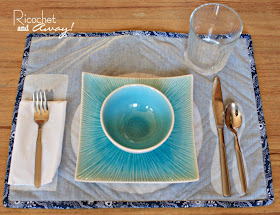Way back last summer, I started some quilted placemats for our table. I started 8 placemats and finished 2 which I proudly gifted away to our dear cousins. I called the 2-sided mats Mullet Mats:
So I finally finished the last 6 placemats!!!! It only took about 6 months!!!
The mats are reversible with one "fancy" side comprised of patchwork:
The other, "utilitarian", side is printed with a place setting:
Growing up, the proper placement of silverware and napkins on the dining room table was not enforced. In fact, I remember most of our meals were self-serve from the kitchen stove, and we brought our plates and forks to the table or to the couch in front of the TV. My first encounter with place settings was at Girl Scout Camp, where I thought the whole ordeal was a pointless ritual.
It wasn't until I was grown, married, and had my first child that I committed to eating all meals at the table. Why the change of routine? Being a new mom, I was reading everything I could get my hands on about raising kids. I noticed that nearly every source recommended eating together as a family every day. So I did. (Mr. Ricochet was less than keen about missing his dinnertime show, but he eventually came around to my way of thinking.)
After 8 years of this routine, I can tell you my 8 and 6 year olds have excellent table manners. They are deft at buttering their own bread and cutting their own meat. Plus, we can rarely go out to dinner anywhere without someone coming up to our table and commenting on how well mannered and polite our kids are. The biggest benefit by far is maintaining a connection with each other. We love dinner and not just because it's a prelude to dessert!
The kids have been setting the table for some time now, and these new printed place mats have injected a little fun into the chore. They remind the kids to cut with their right hands too--something that tends to slip their minds from time to time.
I made printed on these mats using a freezer paper stencil, something I'm sure you've all heard of before. Used to be freezer paper was for wrapping up your meats. But some brilliant (seriously clever) individual found out one could iron freezer paper to fabric (and use it over and over again!), it moved from the kitchen drawer to the craft room in a hurry!
I have never used fabric paint, so I can't comment on whether or not acrylic craft is better or worse for printing on fabrics. I can say that my results are wonderful, and the print still looks great after a few machine washes. The paint I used was a pearl variety by Martha Stewart:
It used to be acrylic craft paint was for painting birdhouses and the like,but nowadays I'm finding all sorts of alternative uses for craft paints. Maybe you've read my tutorial on
No Dye Tie Dye?
I started this project by drawing out my place setting on a sheet of freezer paper:
After carefully cutting out all the shapes, I ironed the paper to some fabric.
Note how I treated the fork and napkin differently than the rest of the flatware.
I also added a circle within the plate just to save paint:
And here's what I ended up with after pulling off the freezer paper:
And here's 4 mats that are complete:
Here's a better photo taken in natural light so the colors are true:
The "pearl" of the paint is subtle. It has an almost reflective metallic quality when the light hits it just right. I'm pleased with the results. I'm excited to show off the "fancy" patchwork sides next time I have my friends over for coffee.
How about you all:
Where did you eat meals as a kid compared to now?
Have you ever tried the freezer paper stencil method for printing on fabric?
I love freezer paper for drafting sewing pattern. What do you use it for?
Happy crafting and big hugs from Montana,










































